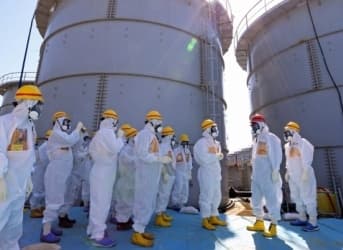Three years after the nuclear catastrophe that struck TEPCO's Fukushima complex, the Japanese government of Prime Minister Shinzuo Abe is slowly sidling back towards restarting Japan’s idled NPPs. On 25 February Abe announced Japan’s new Basic Energy Plan, which sees nuclear power as an important base load energy source and overturns a promise made by a previous government to phase out the country’s 50 operable nuclear reactors. Abe has been promising to add nuclear power back into Japan’s energy mix since soon after he took office in late 2012.
On 11 March 2011 a 9.0 magnitude earthquake struck off the coast of Sendai, Japan, triggering a large tsunami. The damage to TEPCO’s Fukushima Daiichi nuclear power complex resulted in an immediate shutdown of about 10 GW of nuclear electric generating capacity. Up to May 2012, Japan lost all of its nuclear capacity as a result of scheduled maintenance and lack of government approvals to return to operation. Two nuclear reactors were recomissioned in July 2012 and represented Japan’s only source of nuclear power for more than one year. However, these two reactors were removed from service again in September 2013, eliminating the country's nuclear capacity for a second time in more than 40 years.
Related Article: Breakthrough in Fusion Research Brings New Nuclear Power Source Closer
Nuclear generation in Japan represented about 26 percent of Japan’s electrical power generation capability prior to the 2011 earthquake. Currently three of Japan’s reactors, are more than 40 years and 13 are over 30 years old. The reactors were supposed to be decommissioned after 40 years but can now apply for a maximum two-decade extension.
Abe’s new Basic Energy Plan has hit opposition, as it was supposed to be approved by the ruling parties before the end of the fiscal year on 31 March, but it has been repeatedly delayed due to the opposition of anti-nuclear parliamentarians in both his Liberal Democratic Party and coalition partner Komeito party.
For Japan’s embattled anti-nuclear activists, another battleground is looming later this year. A Plutonium Nuclear Fuel Reprocessing Plant at Rokkasho is scheduled to open in October.
The Rokkasho Nuclear Fuel Reprocessing Facility is a nuclear reprocessing plant with an annual capacity of 800 tons of uranium or 8 tons of plutonium, enough to build as many as 2,000 bombs. The Rokkasho Nuclear Fuel Reprocessing Facility is owned by Japan Nuclear Fuel Ltd and replaces a smaller reprocessing plant located in T?kai, Ibaraki in central Japan, which ceased operation in 2007.
Japan was one of 35 nations at the March Nuclear Security Summit in The Hague, where it pledged to strengthen security measures through self-assessments and external reviews. At the NSS both China and South Korea raised concerns about the $21 billion Rokkasho facility, expressing concerns that the reprocessed material could be used to make nuclear weapons. As Japan’s NPPs are currently offline, it is unclear to Japan’s neighbors why so much material is needed, as storing more than is required for use is against IAEA regulations.
Related Article: Three Years After Fukushima, What’s Next for Nuclear Power?
Inside Japan, anti-Rokkasho activists have established a website, http://stop-rokkasho.org.The Rokkasho Nuclear Fuel Reprocessing Facility has even raised objections from the Obama administration, which fears opening the facility could spark a broader race for nuclear technologies and even nuclear weaponry in North Asia and the Middle East and last year conveyed concerns about the security of surplus plutonium in Japan. U.S. officials believe that China, South Korea and Taiwan are closely monitoring Rokkasho and its possible regional impact.
For the moment however, the Abe administration is pressing forward with its plans to bring the Rokkasho Nuclear Fuel Reprocessing Facility online by the end of the year.
Seeking to allay domestic and foreign concerns, Japan Nuclear Fuel spokesman Yasufumi Fukushi emphasized that the United Nations' nuclear watchdog, the International Atomic Energy Agency, will closely monitor Rokkasho's operation to guard against potential diversion of the weapons-usable plutonium, commenting, "Japan accepts regular and irregular inspections from the IAEA and makes public how it handles and uses plutonium, which proves that Japan makes a peaceful use of it."
ADVERTISEMENT
Only time will tell if Mr. Fukushi’s predictions prove accurate.
By John Daly of Oilprice.com


















